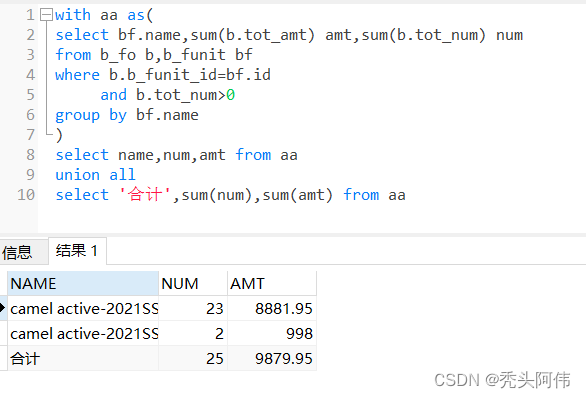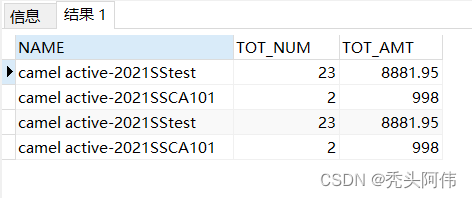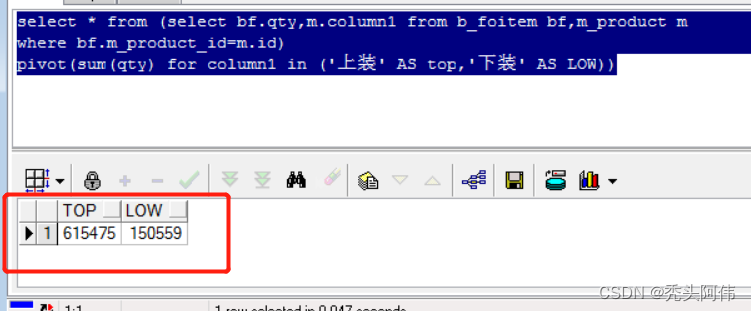一、基础语法
1、CTE:公用表表达式
语法:With 表名 as (查询语句)
作用:将一段查询结果作为公用表,在该条完整SQL中能够使用公用表的查询结果进行查询
示例:
with aa as(
select bf.name,sum(b.tot_amt) amt,sum(b.tot_num) num
from b_fo b,b_funit bf
where b.b_funit_id=bf.id
and b.tot_num>0
group by bf.name
)
select name,num,amt from aa
union all
select '合计',sum(num),sum(amt) from aa
运行效果如下图

2、HAVING
语法:接在SQL最后
作用:在使用了where表达式之后,没办法进和合计函数一起使用。该表达式解决此问题
示例:
select bf.name,sum(b.tot_amt) amt,sum(b.tot_num) num
from b_fo b,b_funit bf
where b.b_funit_id=bf.id
and b.tot_num>0
group by bf.name
Having sum(b.tot_amt) >1000000
--判断查询标准金额大于XX的数据
3、union
语法:union 和 union all
作用:用于拼接两条查询结果集,要求两条查询结果的列数和数据类型需要一致
示例:
- union:出现重复的数据,只会显示一条
select bf.name,b.tot_num,b.tot_amt from b_fo b,b_funit bf
where b.b_funit_id=bf.id
and b.tot_num>0
union
select bf.name,b.tot_num,b.tot_amt from b_fo b,b_funit bf
where b.b_funit_id=bf.id
and b.tot_num>0
查询结果如下图

2.union all:显示所有查询结果
select bf.name,b.tot_num,b.tot_amt from b_fo b,b_funit bf
where b.b_funit_id=bf.id
and b.tot_num>0
union all
select bf.name,b.tot_num,b.tot_amt from b_fo b,b_funit bf
where b.b_funit_id=bf.id
and b.tot_num>0
查询结果如下图:

4、nvl(字符串,替换函数)
用于判断指定数据结果为NULL时,使用什么字符替换显示
select nvl(phone,'未维护手机号') from users
5、pivot()
用来进行行转列的操作
select * from (select bf.qty,m.column1 from b_foitem bf,m_product m
where bf.m_product_id=m.id)
pivot(sum(qty) for column1 in ('上装' AS top,'下装' AS LOW))
比如如上代码的输出结果为

当我们需要将某个字段每一个值都按照列来显示时,使用这个函数来进行转换。
语法:pivot(聚合字段 for 转列字段 in (取别名))
注意:
1.这个函数中 for前面的一定是一个聚合函数包裹起来的
2.这个函数不能接在where那些后面。只能够直接接在from表的后面
3.in()里面的字段需要使用一个括号括起来,并且里面取别名时,原字段需要用’'框起来。别名则不需要
6.decode(if,条件1)
decode相当于一个简单的if判断条件
select SUM(bf.qty),decode(m.column1,'上装',12,'下装',55,88) from b_foitem bf,m_product m
where bf.m_product_id=m.id
group by m.column1
#解释:当column1等于上装的时候查询结果集为12,为下装的时候结果集为55,否则就是88
最终输出结果为

7.查询语句中增加合计维度
SELECT
decode(grouping (dim5.attribname),1,'-',nvl( dim5.attribname, '其它' )) 大类,
decode(grouping ( dim6.attribname ),1,dim5.attribname || '合计',nvl( dim6.attribname, '其它' )) 中类,
--grouping和grouping_id 区别
/*
grouping 中的参数只能够存放一列。如果在多维护合计时不太好用。如果是合计行返回值为1,否则为0
grouping_id 中的参数可以存放多个.返回值是2进制转换为10进制的数
举例: 比如我有三个维度,我需要给一个总的合计,那么对应的grouping_id出来的返回值应该是
二进制数: 1 1 1
十进制数: 4+2+1 = 7
*/
sum( bf.qty ) 数量
FROM
b_foitem bf,
m_product m,
m_dim dim5,
m_dim dim6
WHERE
bf.m_product_id ( + ) = m.id
AND m.m_dim5_id = dim5.id ( + )
AND m.m_dim6_id = dim6.id ( + )
GROUP BY
--grouping sets ( dim5.attribname, dim6.attribname ) 取得期望值。也就是只显示合计值
--cube ( dim5.attribname, dim6.attribname ) 会将所填写的几种合计方式汇总在一个查询结果集里面返回
rollup ( dim5.attribname, dim6.attribname ) --根据维度合计,保留一个结果集
ORDER BY
dim5.attribname
1.分维度合计是根据 rollup(),括号里面填写合计维度
2.在from 前面的grouping()是提供的函数,能够将合计的NULL返回一个1,方便我们判断显示合计的提示
8. 某个字段需要使用拼接符拼接成为一条数据
listagg(name,',') within group(order by name)
使用listagg(字段,分隔符) within group(order by 字段)
示例:
select listagg(name,',') within group(order by name) from ad_table where description like '%起订量%';
将描述包含起订量的名称,使用逗号拼接起来
比如需要获取尺码颜色中每个尺码组有哪些数据,并使用逗号隔开
select attribname,listagg(value,',') within group(order by orderno) from I_CLRSIZE where attribname <> '颜色' group by attribname
9. case when 用法介绍
case when 相当于在Java中的if else,当满足条件时返回某个结果
select name,
case
when attribname = 'A' then
'这个是A'
when attribname = 'B' then
'这个是B'
else
'不知道是谁'
end
from m_product





















 1752
1752











 被折叠的 条评论
为什么被折叠?
被折叠的 条评论
为什么被折叠?








